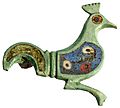Fibula (brooch) facts for kids
A fibula is a type of ancient brooch. Think of it like a fancy safety pin from a long, long time ago! The word "fibula" comes from latin and originally meant brooches used by the Romans. But today, we use this word for brooches from all over the ancient world and the early Middle Ages.
Unlike the brooches we wear just for decoration today, fibulae had a very important job. They were used to fasten clothes, especially cloaks, keeping them closed. Before fibulae, people used straight pins to hold their clothes together during the Neolithic period and the Bronze Age. Later, in the Middle Ages, buttons became popular and replaced fibulae for fastening clothes.
It's cool to know that the modern safety-pin is actually a descendant of the ancient fibula! People still use safety pins today for many things.
Types of Fibulae
There are hundreds of different kinds of fibulae! They come in many shapes and sizes. Experts usually group them based on:
- The time period they were made (like Roman fibulae or early medieval ones).
- The place where they were found (like fibulae from Spain or Italy).
- The culture that made them (like Celtic or Germanic fibulae).
Fibulae are also sorted by their general shape. For example, some look like a bow, while others are flat plates. Each type tells us a little more about the people who made and wore them long ago.
Images for kids
-
Germanic fibulæ, early 5th century, Kunsthistorisches Museum, Vienna
-
These eagle-shaped fibulae, dating from the 6th century were found at Tierra de Barros (Spain, then the Kingdom of the Visigoths) and are made of sheet gold over bronze. The Walters Art Museum.
-
Lombardic gilded silver brooch from Tuscany, c.600 AD, one of the largest of its kind (British Museum)
-
Detail of the Elder Futhark runic inscription on the pinholder of the 3rd-century AD Værløse Fibula followed by a swastika.
-
High status Frankish brooches in the British Museum, France 5th Century AD
-
The pseudo-penannular Tara Brooch, the most ornate of Irish brooches, also decorated on the back (see article). Early 8th century.
See also
 In Spanish: Fíbula para niños
In Spanish: Fíbula para niños






























